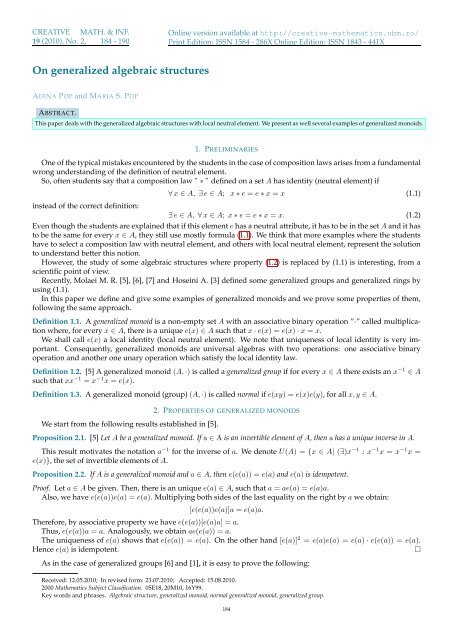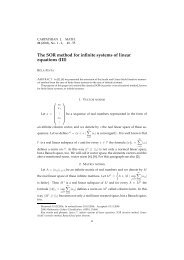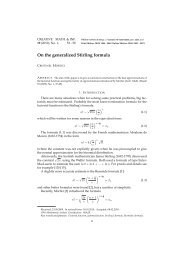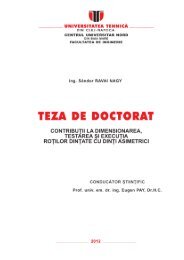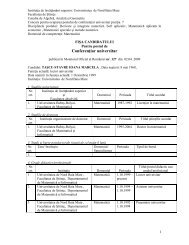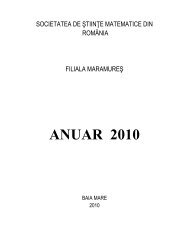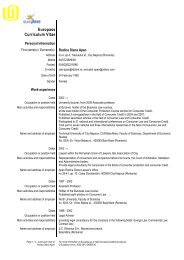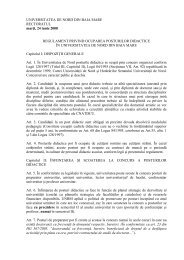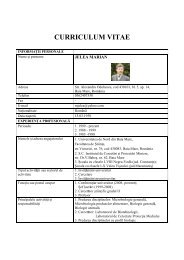On generalized algebraic structures - Creative Math. and Inf.
On generalized algebraic structures - Creative Math. and Inf.
On generalized algebraic structures - Creative Math. and Inf.
You also want an ePaper? Increase the reach of your titles
YUMPU automatically turns print PDFs into web optimized ePapers that Google loves.
CREATIVE MATH. & INF.<br />
19 (2010), No. 2, 184 - 190<br />
<strong>On</strong>line version available at http://creative-mathematics.ubm.ro/<br />
Print Edition: ISSN 1584 - 286X <strong>On</strong>line Edition: ISSN 1843 - 441X<br />
<strong>On</strong> <strong>generalized</strong> <strong>algebraic</strong> <strong>structures</strong><br />
ADINA POP <strong>and</strong> MARIA S. POP<br />
ABSTRACT.<br />
This paper deals with the <strong>generalized</strong> <strong>algebraic</strong> <strong>structures</strong> with local neutral element. We present as well several examples of <strong>generalized</strong> monoids.<br />
1. PRELIMINARIES<br />
<strong>On</strong>e of the typical mistakes encountered by the students in the case of composition laws arises from a fundamental<br />
wrong underst<strong>and</strong>ing of the definition of neutral element.<br />
So, often students say that a composition law ” ∗ ” defined on a set A has identity (neutral element) if<br />
∀ x ∈ A, ∃ e ∈ A; x ∗ e = e ∗ x = x (1.1)<br />
instead of the correct definition:<br />
∃ e ∈ A, ∀ x ∈ A; x ∗ e = e ∗ x = x. (1.2)<br />
Even though the students are explained that if this element e has a neutral attribute, it has to be in the set A <strong>and</strong> it has<br />
to be the same for every x ∈ A, they still use mostly formula (1.1). We think that more examples where the students<br />
have to select a composition law with neutral element, <strong>and</strong> others with local neutral element, represent the solution<br />
to underst<strong>and</strong> better this notion.<br />
However, the study of some <strong>algebraic</strong> <strong>structures</strong> where property (1.2) is replaced by (1.1) is interesting, from a<br />
scientific point of view.<br />
Recently, Molaei M. R. [5], [6], [7] <strong>and</strong> Hoseini A. [3] defined some <strong>generalized</strong> groups <strong>and</strong> <strong>generalized</strong> rings by<br />
using (1.1).<br />
In this paper we define <strong>and</strong> give some examples of <strong>generalized</strong> monoids <strong>and</strong> we prove some properties of them,<br />
following the same approach.<br />
Definition 1.1. A <strong>generalized</strong> monoid is a non-empty set A with an associative binary operation ”·” called multiplication<br />
where, for every x ∈ A, there is a unique e(x) ∈ A such that x · e(x) = e(x) · x = x.<br />
We shall call e(x) a local identity (local neutral element). We note that uniqueness of local identity is very important.<br />
Consequently, <strong>generalized</strong> monoids are universal algebras with two operations: one associative binary<br />
operation <strong>and</strong> another one unary operation which satisfy the local identity law.<br />
Definition 1.2. [5] A <strong>generalized</strong> monoid (A, ·) is called a <strong>generalized</strong> group if for every x ∈ A there exists an x −1 ∈ A<br />
such that xx −1 = x −1 x = e(x).<br />
Definition 1.3. A <strong>generalized</strong> monoid (group) (A, ·) is called normal if e(xy) = e(x)e(y), for all x, y ∈ A.<br />
We start from the following results established in [5].<br />
2. PROPERTIES OF GENERALIZED MONOIDS<br />
Proposition 2.1. [5] Let A be a <strong>generalized</strong> monoid. If a ∈ A is an invertible element of A, then a has a unique inverse in A.<br />
This result motivates the notation a −1 for the inverse of a. We denote U(A) = {x ∈ A| (∃)x −1 : x −1 x = x −1 x =<br />
e(x)}, the set of invertible elements of A.<br />
Proposition 2.2. If A is a <strong>generalized</strong> monoid <strong>and</strong> a ∈ A, then e(e(a)) = e(a) <strong>and</strong> e(a) is idempotent.<br />
Proof. Let a ∈ A be given. Then, there is an unique e(a) ∈ A, such that a = ae(a) = e(a)a.<br />
Also, we have e(e(a))e(a) = e(a). Multiplying both sides of the last equality on the right by a we obtain:<br />
[e(e(a))e(a)]a = e(a)a.<br />
Therefore, by associative property we have e(e(a))[e(a)a] = a.<br />
Thus, e(e(a))a = a. Analogously, we obtain ae(e(a)) = a.<br />
The uniqueness of e(a) shows that e(e(a)) = e(a). <strong>On</strong> the other h<strong>and</strong> [e(a)] 2 = e(a)e(a) = e(a) · e(e(a)) = e(a).<br />
Hence e(a) is idempotent.<br />
□<br />
As in the case of <strong>generalized</strong> groups [6] <strong>and</strong> [1], it is easy to prove the following:<br />
Received: 12.05.2010; In revised form: 23.07.2010; Accepted: 15.08.2010.<br />
2000 <strong>Math</strong>ematics Subject Classification. 05E18, 20M10, 16Y99.<br />
Key words <strong>and</strong> phrases. Algebraic structure, <strong>generalized</strong> monoid, normal <strong>generalized</strong> monoid, <strong>generalized</strong> group.<br />
184
Proposition 2.3. Let (A, ·) be a <strong>generalized</strong> monoid <strong>and</strong> let a ∈ U(A). Then:<br />
a) e(a −1 ) = e(a);<br />
b) (a −1 ) −1 = a.<br />
<strong>On</strong> <strong>generalized</strong> <strong>algebraic</strong> <strong>structures</strong> 185<br />
Proposition 2.4. Let (A, ·) be a normal <strong>generalized</strong> monoid. If a, b ∈ U(A) such that e(a)b −1 = b −1 e(a), then (ab) −1 =<br />
b −1 · a −1 .<br />
In [6], Molaei shows that an abelian <strong>generalized</strong> group is a group. It is easy to see that every group is a Molaei’s<br />
<strong>generalized</strong> group.<br />
In [2], Araújo <strong>and</strong> Konieczny prove that the <strong>generalized</strong> groups are completely simple semigroups, which represent<br />
a well known class of semigroups in semigroup theory.<br />
In the special case of the <strong>generalized</strong> monoids, the notions of submonoid, <strong>and</strong> homomorphism of <strong>generalized</strong><br />
monoids can be extended from the theory of universal algebra as follows.<br />
Definition 2.4. Let (A, ·) be a <strong>generalized</strong> monoid. A non-empty subset B ⊆ A is said to be a <strong>generalized</strong> submonoid<br />
of A if for any x, y ∈ B we have xy ∈ B <strong>and</strong> for any x ∈ B we have e(x) ∈ B.<br />
It is easy to prove the following<br />
Theorem 2.1. Let {B i ; i ∈ I} be a family of <strong>generalized</strong> submonoids of the <strong>generalized</strong> monoid (A, ·), <strong>and</strong> ⋂ B i ≠ ∅. Then<br />
⋂<br />
i∈I<br />
B i is a <strong>generalized</strong> submonoid of A.<br />
i∈I<br />
Proposition 2.5. If (A, ·) is a <strong>generalized</strong> monoid <strong>and</strong> a ∈ A is fixed, then the set denoted by A a = {x ∈ A; e(x) = e(a)} is a<br />
<strong>generalized</strong> submonoid of A. In fact A a is a monoid.<br />
Proof. For all x, y ∈ A a we have e(x) = e(y) = e(a). Therefore<br />
(xy)e(a) = x(ye(a)) = x(ye(y)) = xy.<br />
Analogously, we have e(a)xy = (e(a)x)y = (e(x)x)y = xy.<br />
Thus e(xy) = e(a), that is, xy ∈ A a . From Proposition 2.2, if x ∈ A a , we have e(e(x)) = e(x) = e(a). Hence<br />
e(x) ∈ A a .<br />
□<br />
Remark 2.1. In a normal <strong>generalized</strong> monoid A, the set of local identities E(A) = {e(x); x ∈ A} is a <strong>generalized</strong><br />
submonoid of the <strong>generalized</strong> monoid A.<br />
Remark 2.2. Note that not every monoid is a <strong>generalized</strong> monoid. For instance, the set of residue classes modulo<br />
6, Z 6 , with multiplication ” · ” defined by ̂x · ŷ = ̂x · y is a monoid, but it isn’t a <strong>generalized</strong> monoid because ̂3 · ̂1 =<br />
̂3 · ̂3 = ̂3 · ̂5 = ̂3.<br />
If, in addition, the monoid (M, ·, 1) has the set local identities E(M) = {1} then it is a <strong>generalized</strong> monoid.<br />
Example 2.1. Let the set N 3 . We define the binary operation ” ∗ ” as follows<br />
(m, n, p) ∗ (m ′ , n ′ , p ′ ) = (m, n + n ′ , p ′ ).<br />
Then (N 3 , ∗) is a normal <strong>generalized</strong> monoid where e((m, n, p)) = (m, 0, p). Subsets N × 2N × N <strong>and</strong> N × {0} × N are<br />
<strong>generalized</strong> submonoids of the <strong>generalized</strong> monoid (N 3 , ∗).<br />
Example 2.2. The set N × N ∗ × N with the binary operation ”◦”:<br />
(m, n, p) ◦ (m ′ , n ′ , p ′ ) = (m, nn ′ , p ′ )<br />
(N × N ∗ × N, ◦) is a normal <strong>generalized</strong> monoid <strong>and</strong> e((m, n, p)) = (m, 1, p).<br />
We note that any element of the form (m, 0, p) must be excluded (because of them local neutral element isn’t<br />
unique):<br />
(m, 0, p) ◦ (m, n ′ , p) = (m, 0, p), ∀ n ′ ∈ N.<br />
Example 2.3. The pair (Z 3 , ∗), where ”∗” is a binary operation defined in Example 2.1, is a normal <strong>generalized</strong> group<br />
where (m, n, p) −1 = (m, −n, p), <strong>and</strong> (N 3 , ∗) from Example 2.1 is a submonoid of (Z 3 , ∗).<br />
Example 2.4. Let the set of matrices M 3 (N). We define the operation ”∗” as follows<br />
⎛<br />
⎝ a b c<br />
⎞ ⎛ ⎞ ⎛<br />
⎞<br />
d e f⎠ ∗ ⎝ a′ b ′ c ′ a b c<br />
d ′ e ′ f ′ ⎠ = ⎝d + d ′ e + e ′ f + f ′ ⎠ .<br />
g h i g ′ h ′ i ′ g ′ h ′ i ′<br />
Then (M 3 (N), ∗) is a normal <strong>generalized</strong> monoid where<br />
( ⎛<br />
e ⎝ a b c<br />
⎞ ⎛<br />
)<br />
d e f ⎠ = ⎝ a b c<br />
⎞<br />
0 0 0 ⎠ .<br />
g h i g h i<br />
The set M 3 (Z) with the binary operation defined as above is a normal <strong>generalized</strong> group <strong>and</strong> M 3 (N) is a normal<br />
<strong>generalized</strong> submonoid.
186 Adina Pop <strong>and</strong> Maria S. Pop<br />
Example 2.5. The set of residue classes modulo 6, Z 6 , with operation ” ∗ ” defined by ̂x ∗ ŷ = 3̂x + 4ŷ is a normal<br />
<strong>generalized</strong> group in which every element is idempotent.<br />
Remark 2.3. In fact, a <strong>generalized</strong> monoid which has all its elements idempotent is a <strong>generalized</strong> group.<br />
3. RESULTS ON HOMOMORPHISM OF GENERALIZED MONOIDS<br />
Definition 3.5. Let (A, ∗), (B, ◦) be two <strong>generalized</strong> monoids. The map f : A → B is called a homomorphism of<br />
<strong>generalized</strong> monoids if for any x, y ∈ A, we have f(x ∗ y) = f(x) ◦ f(y).<br />
If f is an injective homomorphism, then we say that f can be embedded in (B, ◦).<br />
If f is a bijective homomorphism, then f is called isomorphism.<br />
Remark 3.4. Let f : A → B be an homomorphism of <strong>generalized</strong> monoids, by uniqueness of local identity it follows<br />
that for any x ∈ A, f(e A (x)) = e B (f(x)) is a local identity in the <strong>generalized</strong> monoid B.<br />
Remark 3.5. Let (A, ∗) <strong>and</strong> (B, ◦) be two <strong>generalized</strong> monoids, f : A → B a homomorphism of <strong>generalized</strong> monoids<br />
<strong>and</strong> a ∈ A an invertible element. Then f(a) is invertible <strong>and</strong> [f(a)] −1 = f(a −1 ).<br />
Definition 3.6. Let f : A → B be a <strong>generalized</strong> monoid homomorphism <strong>and</strong> a ∈ A. Then the set which is denoted<br />
by (Ker f) a = {x ∈ A, f(x) = e B (f(a))} is called the kernel at a. Obviously, (Ker f) a = {x ∈ A; f(x) = f(e A (a))}.<br />
Remark 3.6. Let (A, ·) be a normal <strong>generalized</strong> monoid. Then the map e : A → A, x → e(x) is an endomorphism of<br />
A <strong>and</strong> (Ker e) a = A a .<br />
Definition<br />
⋃<br />
3.7. Let f : A → B be a <strong>generalized</strong> monoids homomorphism. Then the set denoted by Ker f =<br />
(Ker f) a is called the kernel of f.<br />
a∈A<br />
Note that Ker f = E(A).<br />
Example 3.6. The map f : (N 3 , +) → (N × N ∗ × N, ◦), f((m, n, p)) = (m, 2 n , p) is an injective homomorphism of<br />
<strong>generalized</strong> monoids, where<br />
(Ker f) (m,n,p) = {(m, o, p)} <strong>and</strong> Ker f = N × {0} × N.<br />
Proposition 3.6. A cancellative <strong>generalized</strong> monoid is a monoid.<br />
Proof. Let x, y ∈ A <strong>and</strong> e(x), e(y) be the local identities of them. By associative law, we have xye(xy) = xy =<br />
x(ye(y)) = xye(y). Because the cancellative law holds, we obtain y = ye(xy) <strong>and</strong> e(xy) = e(y).<br />
Analogously, by e(xy)xy = xy = e(x)xy it follows that e(xy) = e(x). Thus, for every x, y ∈ A we have e(x) =<br />
e(y) = e.<br />
□<br />
The construction of <strong>generalized</strong> group given by Araújo <strong>and</strong> Konieczny [2] leads to the next result.<br />
Proposition 3.7. Any monoid (M, ·, 1) with E(M) = {1} can be embedded in a normal <strong>generalized</strong> monoid.<br />
Proof. Let (M, ·, 1) be a monoid, I <strong>and</strong> J be two non-empty sets. <strong>On</strong> the set A = I × M × J we define the binary<br />
operation ”∗” as follows:<br />
(i 1 , m 1 , j 1 ) ∗ (i 2 , m 2 , j 2 ) = (i 1 , m 1 m 2 , j 2 ).<br />
It is easily verified that the operation ”∗” is associative <strong>and</strong> for every (i, m, j) ∈ A there exists the local identity<br />
e((i, m, j)) = (i, 1, j). Besides, for every<br />
x = (i 1 , m 1 , j 1 ) ∈ A, y = (i 2 , m 2 , j 2 ) ∈ A we have<br />
e(x ∗ y) = e((i 1 , m 1 m 2 , j 2 )) = (i 1 , 1, j 2 ) = (i 1 , 1, j 1 ) ∗ (i 2 , 1, j 2 ) = e(x) ∗ e(y).<br />
Therefore, (A, ∗) is a normal <strong>generalized</strong> monoid.<br />
Let (i, j) ∈ I × J be an arbitrary fixed pair. The set S ij = {i} × M × {j} is a submonoid of (A, ∗) isomorphic with<br />
(M, ·, 1) because the map f<br />
⋃<br />
: M → A, f(x) = (i, x, j), is an injective homomorphism where f(M) = S ij .<br />
Moreover, I × M × J = S ij .<br />
□<br />
(i,j)∈I×J<br />
Proposition 3.8. If (A, ·) is a <strong>generalized</strong> monoid <strong>and</strong> x ∈ A is idempotent, then e(x) = x <strong>and</strong> x ∈ U(A).<br />
Proof. From x 2 = x it results xx = x = xe(x). From uniqueness of local identity of x we have that x = e(x).<br />
So, xx = x = e(x). From uniqueness of inverse of x it results x −1 = x <strong>and</strong> x ∈ U(A).<br />
Corollary 3.1. Let (A, ·) be a normal <strong>generalized</strong> monoid. The set of idempotents denoted by I(A) is a normal <strong>generalized</strong><br />
group.<br />
Proof. Let x, y ∈ I(A). From Proposition 3.8 we have x = e(x) <strong>and</strong> y = e(y).<br />
Because A is a normal <strong>generalized</strong> monoid, from (xy)e(xy) = xy we have<br />
(xy)[e(x)e(y)] = xy. Thus, (xy)(xy) = xy <strong>and</strong> so (xy) 2 = xy that is xy ∈ I(A). For every x ∈ I(A) there is e(x) = x<br />
<strong>and</strong> [e(x)] 2 = e(x). So, e(x) ∈ I(A).<br />
From Proposition 3.8 we have x = x −1 for every x ∈ I(A). Hence, I(A) is a normal <strong>generalized</strong> group. □<br />
□
<strong>On</strong> <strong>generalized</strong> <strong>algebraic</strong> <strong>structures</strong> 187<br />
Remark 3.7. Note that there are non idempotents in a <strong>generalized</strong> monoid, which have idempotents local neutral<br />
elements.<br />
For instance, in the <strong>generalized</strong> monoid (N 3 , ∗) by Example 2.1 the set of idempotents is composed only by local<br />
identities.<br />
The map e : N 3 → N 3 is a non injective endomorphism. Indeed, if a = (m, n, p), then a ≠ a 2 for n ≠ 0 <strong>and</strong><br />
e(a 2 ) = e(a). The set A a ∈ A/ ker e is the equivalence class of partition A/ ker e <strong>and</strong> ker e is an equivalence relation on<br />
A.<br />
We have the following correspondence theorem.<br />
Proposition 3.9. Let (A, ∗) <strong>and</strong> (B, ◦) be two <strong>generalized</strong> monoids <strong>and</strong> f : A → B an homomorphism.<br />
a) If M is a <strong>generalized</strong> submonoid of A, then f(M) is a <strong>generalized</strong> submonoid of B;<br />
b) If N is a <strong>generalized</strong> submonoid of B <strong>and</strong> f −1 (N) ≠ ∅, then f −1 (N) is a <strong>generalized</strong> submonoid of A;<br />
c) If A is a normal <strong>generalized</strong> monoid, the set X = {(e A (a), f(a))|a ∈ A} with binary operation ”∗” defined by (e A (a), f(a))∗<br />
(e A (b), f(b)) = (e A (ab), f(ab)), is a <strong>generalized</strong> monoid.<br />
Proof. a) If M is a <strong>generalized</strong> submonoid of A, then for every a, b ∈ M, we have ab ∈ M <strong>and</strong> for any a ∈ M we have<br />
e(a) ∈ M.<br />
For every x, y ∈ f(M) there exist a, b ∈ M such that f(a) = x, f(b) = y. So xy = f(a) · f(b) = f(ab) ∈ f(M). If<br />
a ∈ M, then e(a) ∈ M <strong>and</strong>, moreover, f(a) ∈ f(M), f(e A (a)) ∈ f(M), that is e B (f(a)) ∈ f(M).<br />
b) We have f −1 (N) = {a ∈ A|f(a) ∈ N}. If a, b ∈ f −1 (N) it follows that f(a), f(b) ∈ N. Because N is a <strong>generalized</strong><br />
submonoid of B, we have f(a) · f(b) = f(ab) ∈ N, <strong>and</strong> so ab ∈ f −1 (N).<br />
Let a ∈ f −1 (N) namely f(a) ∈ N, be an element. Because N is a <strong>generalized</strong> submonoid of B, we have e B (f(a)) =<br />
f(e A (a)) ∈ N. Therefore e A (a) ∈ f −1 (N) <strong>and</strong> so f −1 (N) is a <strong>generalized</strong> submonoid of A.<br />
c) Let A be a normal <strong>generalized</strong> monoid, that is e A (ab) = e A (a) · e A (b), for all a, b ∈ A. We have<br />
thus operation ”∗” is associative.<br />
For every (e A (a), f(a)) ∈ X we have:<br />
<strong>and</strong><br />
[(e A (a), f(a)) ∗ (e A (b), f(b)] ∗ (e A (c), f(c)) = (e(ab), f(ab)) ∗ (e(c), f(c))<br />
= (e A (abc), f(abc)) = (e A (a), f(a)) ∗ (e A (bc), f(bc))<br />
= (e A (a), f(a)) ∗ [(e A (b), f(b)) ∗ (e A (c), f(c))],<br />
(e A (a), f(a)) ∗ (e A (e A (a)), f(e A (a))<br />
= (e A (a · e A (a)), f(a · e A (a))) = (e A (a), f(a))<br />
(e A (e A (a), f(e A (a))) ∗ (e A (a), f(a))<br />
= (e A (e A (a)a), f(e A (a)a)) = (e A (a), f(a)).<br />
From uniqueness of local identities e A (a) <strong>and</strong> e B (f(a)) = f(e A (a)) it follows that<br />
e((e A (a), f(a))) = (e A (e A (a)), f(e A (a))) = (e A (a), f(e A (a))).<br />
Proposition 3.10. Let (A, ∗), (B, ◦) be two <strong>generalized</strong> monoids <strong>and</strong> f : A → B a <strong>generalized</strong> homomorphism.<br />
a) If a ∈ A, then (Ker f) a is a <strong>generalized</strong> submonoid of A.<br />
b) If f is an injective homomorphism <strong>and</strong> a ∈ A then (Ker f) a = {e A (a)}.<br />
Proof. Because f(e A (a))=e B (f(a)) we have e A (a)∈(Kerf) a <strong>and</strong> so (Kerf) a ≠∅.<br />
For every x, y ∈ (Kerf) a we have<br />
f(x ∗ y) = f(x) ◦ f(y) = e B (f(a)) ◦ e B (f(a))<br />
= f(e A (a)) ◦ f(e A (a)) = f(e A (a) ∗ e A (a)) = f(e A (a)),<br />
From Proposition 2.2 we obtain f(x ∗ y) = f(e A (a)) = e B (f(a)).<br />
Thus x ∗ y ∈ (Ker f) a . Moreover, if x ∈ (Ker f) a then f(e A (x)) = e B (f(x)) = e B (f(e A (a)) = e B (f(e A (a)) =<br />
f(e A (e A (a)).<br />
From Proposition 2.2 we obtain f(e A (x)) = f(e A (a)) <strong>and</strong> so f(e A (x)) = e B (f(a)) hence e A (x) ∈ (Kerf) a .<br />
3) If f is an injective homomorphism <strong>and</strong> x ∈ (Ker f) a then f(x) = e B (f(a)) = f(e A (a)), hence x = e A (a). We get<br />
(Ker f) a ⊆ {e A (a)}. Because f(e A (a)) = e B (f(a)) we have {e A (a)} ⊆ (Ker f) a . Therefore (Ker f) a = {e A (a)}. □<br />
In particulary, for <strong>generalized</strong> group we found theorem 3.5 (ii) in [1], namely:<br />
Corollary 3.2. Let a ∈ G <strong>and</strong> f : G → H be a <strong>generalized</strong> group homomorphism. If Kerf at a is denoted by (Kerf) a = {x ∈<br />
G | f(x) = f(e(a))}, then f is monomorphism if <strong>and</strong> only if (Kerf) a = {e(a)} for all a ∈ G.<br />
Corollary 3.3. If A is a normal <strong>generalized</strong> monoid, then (Ker e) a = A a is a submonoid of A.<br />
□
188 Adina Pop <strong>and</strong> Maria S. Pop<br />
Proposition 3.11. Let (A, ·, 1) be a monoid with E(A) = {1} <strong>and</strong> (B, ∗) be a <strong>generalized</strong> monoid. If f : A → B is a <strong>generalized</strong><br />
monoid homomorphism, then the set B f(1) is a monoid <strong>and</strong> f(A) is a <strong>generalized</strong> submonoid of B f(1) .<br />
Proof. B f(1) = {b ∈ B|e B (b) = e B (f(1))} = {b ∈ B|e B (b) = f(e A (1))}.<br />
Because the element 1 is an identity in A, then e A (1) = 1 <strong>and</strong> so<br />
B f(1) = {b ∈ B | e B (b) = f(1)}.<br />
From Proposition 2.5 it results that the set B f(1) is a monoid.<br />
If a ′ ∈ f(A), then there is a ∈ A such that f(a) = a ′ , so<br />
a ′ f(1) = f(a)f(1) = f(a · 1) = f(a) = a ′<br />
<strong>and</strong><br />
f(1)a ′ = f(1)f(a) = f(1 · a) = f(a) = a ′ .<br />
Hence, e(a ′ ) = f(1) <strong>and</strong> so a ′ ∈ B f(1) .<br />
In conclusion f(A) ⊂ B f(1) . If a ′ , b ′ ∈ f(A) then there exist a, b ∈ A such that f(a) = a ′ , f(b) = b ′ <strong>and</strong> a · b ∈ A. We<br />
have a ′ b ′ = f(a) · f(b) = f(ab) ∈ f(A).<br />
If a ′ ∈ f(A) then e B (a ′ ) = e B (f(a)) = f(e A (a)) = f(1) ∈ f(A).<br />
So, f(A) is a <strong>generalized</strong> submonoid of B f(1) .<br />
□<br />
REFERENCES<br />
[1] Adéniran, J. O., Akimnoyewa, J. T., Sòlárin, A. R. T., Jaiyéolá, T. G., <strong>On</strong> some <strong>algebraic</strong> properties of <strong>generalized</strong> groups, Octogon <strong>Math</strong>ematical<br />
Magazine 17 (2009), No. 1, 125-134<br />
[2] Araújo, J., Konieczny, J., Molaei’s Generalized Groups are Completely Simple Semigroups, Bul. Inst. Pol. Iaşi, Sect. I, Mat. Mec. Teor. Fiz., 48 (52)<br />
(2002), No. 1-2, 1-5<br />
[3] Hoseini, A., <strong>On</strong> M-rings, Italian J. of Pure <strong>and</strong> Appl. <strong>Math</strong>. 12 (2002), 105-111<br />
[4] Mehrabi, M., Molaei, M. R., Olomi, A., Generalized subgroups <strong>and</strong> homomorphisms, Arab J. of <strong>Math</strong>. Sci. 6 (2000), No. 2, 1-7<br />
[5] Molaei, M. R., Generalized groups, Bul. Inst. Pol. Iaşi, Sect. I, Fasc. 3-4, 45 (49) (1999), 21-24<br />
[6] Molaei, M. R., Hoseini, A., <strong>On</strong> <strong>generalized</strong> group, Gazeta Matematică, seria A (2000), No. 1, 36-39<br />
[7] Molaei, M. R., <strong>generalized</strong> rings, Italian J. of Pure <strong>and</strong> Appl. <strong>Math</strong>. (2002), No. 12, 105-111<br />
NORTH UNIVERSITY OF BAIA MARE<br />
DEPARTMENT OF MATHEMATICS AND COMPUTER SCIENCE<br />
VICTORIEI 76, 430122 BAIA MARE, ROMANIA<br />
E-mail address: adina p 2006@yahoo.com<br />
E-mail address: maria sanziana@yahoo.com


